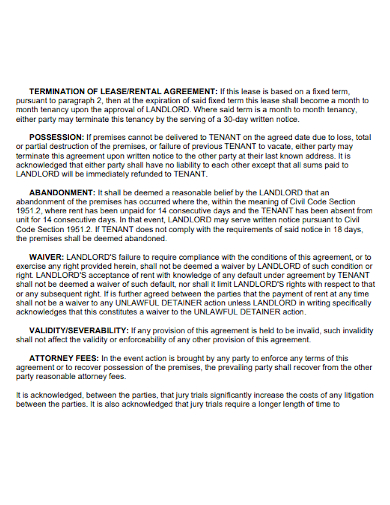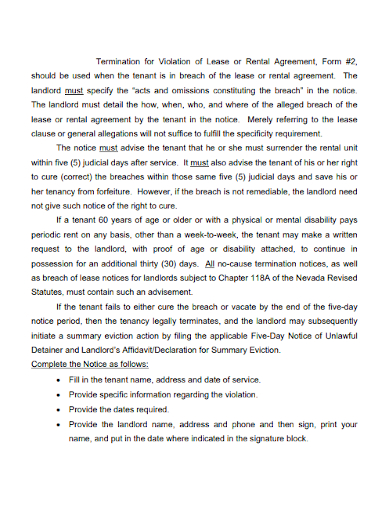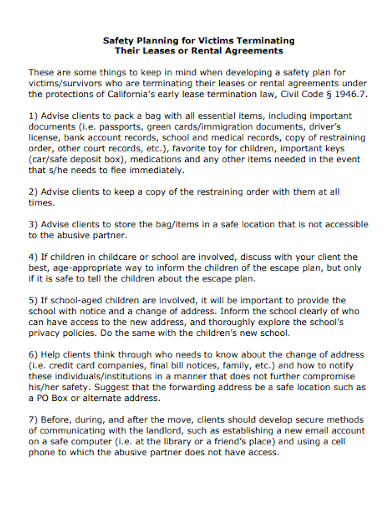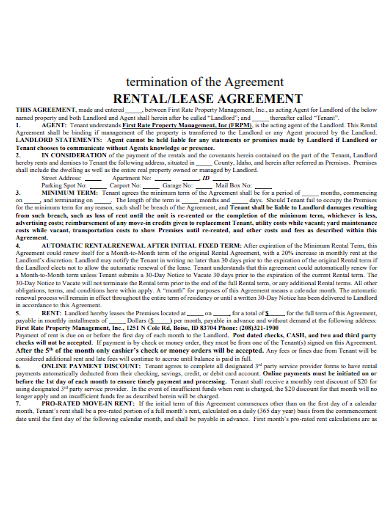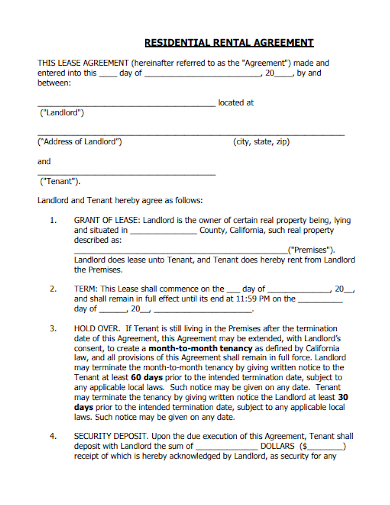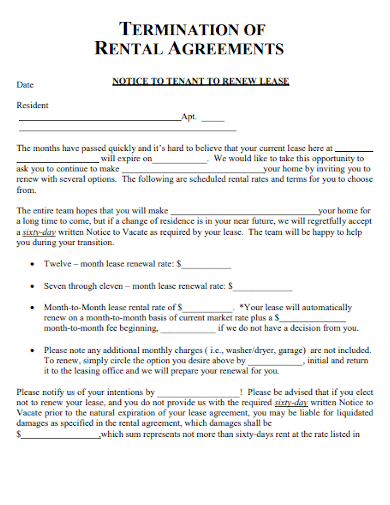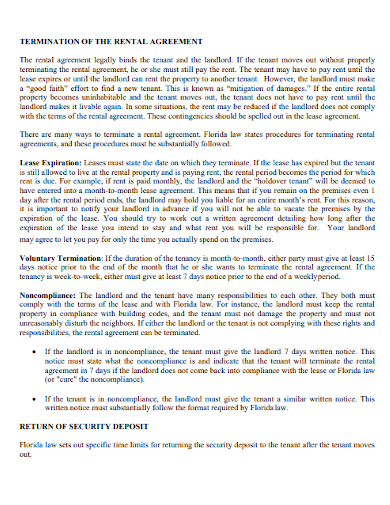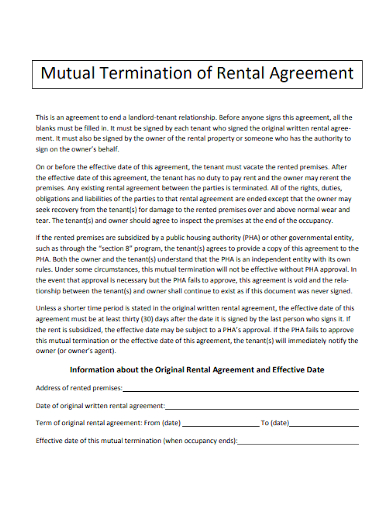An eviction is not the same as a tenancy termination. The landlord asks the tenant to vacate the rented unit if the rental agreement is terminated. Without being evicted, a tenant might have their tenancy terminated and move out. If a renter fails to leave the property, an eviction is a legal procedure of removing them from the property and filing a lawsuit against them.
10+ Termination of Rental Lease Agreement Samples
Tenants on a month-to-month basis must be provided written notice of their landlord’s intention to discontinue their tenancy at least 20 days before the end of the rental period. Notices of 20 days are sometimes known as “no-cause” notices. The landlord does not have to give a reason why they are requesting the tenant to leave in most cities in Washington, and there are currently no extensions in Washington state law. If a tenant who has been given a 20-day notice to evacuate fails to do so within that time frame, they become a “holdover” tenant, and the landlord can sue them for eviction.
1. Termination of Rental Lease Agreement Template
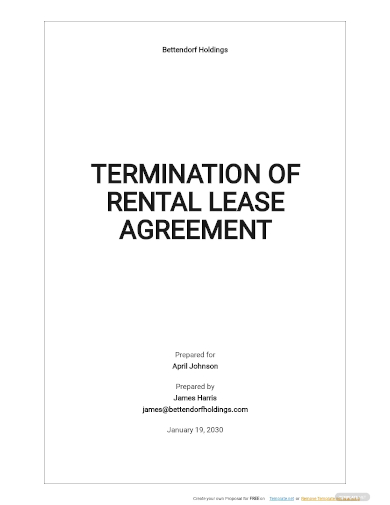
2. Sample Termination of Rental Lease Agreement
3. Termination for Violation of Lease or Rental Agreement
4. Safety Plan for Victims Termination of Rental Lease Agreement
5. Printable Termination of Rental Lease Agreement
6. Termination of Residential Rental Lease Agreement
7. Tenant 30 Day Notice Terminate of Rental Lease Agreement
8. Termination of Rental Renew Tenant Lease Agreement
9. Termination of Rental Lease Lease Expiration Agreement
10. Termination of Rental Lease Agreement by Landlord
11. Mutual Termination of Rental Lease Agreement
Ending your Lease
- Mutual agreement to end – A tenancy can be ended at any moment by the landlord and the tenant(s) without any party being held liable. A mutual termination agreement between the tenant and landlord should be in writing, and it must be signed by everyone on the lease’s list of signatories. Tenants can’t have to pay more than their actual and sensible costs (including lost rent and marketing expenses, but not remuneration for time spent re-renting the apartment), but they can pay more if the landlord asks for a payment, and avoid the risk of the lease being broken if the landlord asks for payment.
- Constructive eviction – A tenant may be able to move out and no longer be liable for lease obligations if the landlord is aware of a serious health or safety issue and has been given a reasonable amount of time to fix it, or if the repairs would cause an undue hardship on the tenant due to the timeline or nature of the repairs. To be able to evict someone constructively, it must be a very serious case. Floods and flames are mentioned as examples in the law. Having building inspector records or other documentation will be crucial in determining if the repairs were serious enough to evict constructively.
- The Safe Housing Act – If a victim of domestic violence, sexual assault, stalking, or child abuse believes they are in imminent danger of physical harm if they remain on the premises and have an accepted form of proof, the Safe Housing Act permits them to terminate their lease (a restraining order, condition of release, or a criminal complaint). Several rules are in place. In these limited instances, the lease would come to an end as if a month-to-month tenancy had been terminated.
- The tenant has died – According to Wis. Stat. 704.165, a lease is canceled 60 days (or before, if the lease ends before the 60 days) after a landlord is notified of a tenant’s death. The tenant’s estate is not accountable for any additional rent beyond 60 days. If the estate surrenders the property before the 60-day period has expired, a landlord would be liable for damages in the same way as if the lease had been broken. For any remaining co-tenants, the lease would still be legal (for instance, a living spouse who was named on the lease).
- Illegal lease clauses – It was not necessary for your landlord to act (or try to act) in violation of the prohibited provision (s). On its own, the presence of the provision(s) in the lease is unconstitutional. Because they drafted the lease, your landlord cannot cancel it without your permission just because it contains an illegal condition.
FAQs
When are landlords not allowed to terminate tenancies?
Tenancies cannot be terminated for any cause, including discrimination or retaliation. Discrimination based on any protected class status, such as race, gender, or handicap, is banned in Washington State (RCW.59.240, RCW 59.18.250). However, winning a retaliation or discrimination claim can be exceedingly difficult, and it may not be enough to stop eviction litigation from advancing. Make sure you get as much documentation as you can in writing. Fair housing rules in your area govern discrimination legislation. Consult your local civil rights agency for additional information.
How does a landlord evict a tenant?
With the help of a law enforcement officer, a court-ordered physical eviction of a tenant and his or her belongings are carried out. If the tenant continues in the rental after receiving a termination notice, the landlord may be required to file an eviction lawsuit, often known as an unlawful detainer action. The landlord must first file a complaint with the court and then wait for the tenant’s response before proceeding with the eviction. The landlord has the legal right to seize the property if the landlord prevails, whether on the merits of the case or because the tenant failed to respond. A law enforcement officer may remove the renter if he or she refuses to leave after receiving the eviction notice.
If you want to see more samples and formats, check out some termination of rental lease agreement samples and templates provided in the article for your reference.
Related Posts
FREE 10+ Mentoring Agreement Samples In MS Word | Apple Pages | PDF
FREE 10+ Partner Agreement Samples In MS Word | Google Docs | Apple Pages | PDF
FREE 10+ Individual Agreement Samples In MS Word | Google Docs | Apple Pages | PDF
FREE 10+ Strategic Agreement Samples In MS Word | Google Docs | Apple Pages | PDF
FREE 10+ Equity Agreement Samples In MS Word | Google Docs | Apple Pages | PDF
FREE 10+ Producer Agreement Samples in MS Word | Apple Pages | PDF
FREE 10+ Grant Agreement Samples In MS Word | Apple Pages | PDF
FREE 8+ Meeting Agreement Samples in MS Word | Google Docs | Apple Pages | PDF
FREE 10+ Community Agreement Samples In MS Word | Google Docs | PDF
FREE 8+ Real Estate Option Agreement Samples in MS Word | PDF
FREE 10+ Call Option Agreement Samples In MS Word | PDF
FREE 10+ Advertising Agreement Samples In MS Word | Google Docs | Apple Pages | PDF
FREE 10+ Car Agreement Samples In MS Word | Google Docs | Apple Pages | PDF
FREE 10+ Horse Agreement Samples In MS Word | Apple Pages | PDF
FREE 10+ Option Agreement Samples In MS Word | Google Docs | Apple Pages | PDF

